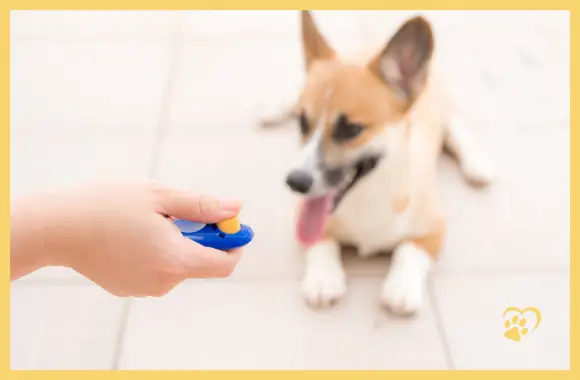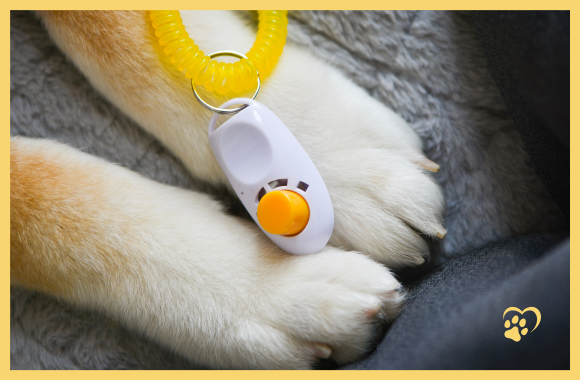Successful dog training is no coincidence, but the result of a well thought-out and consistent strategy. An important tool for this is clicker training. If you don't know it yet, this article will open your eyes. If you have already tried it, you will gain new insights to make it even more effective.
Clicker training is a proven method to shape and improve your dog's behavior. It involves using a small device called a clicker, which sends out a clear signal. This signal tells your dog that he has done something right and that a reward will follow. It is a clear, simple and effective way to communicate with your dog.
We explain the most important do's and don'ts of clicker training so that you can use it successfully. With our tips, you can get the most out of this training method.
Understanding Clicker Training: More than just a click
The world of clicker training: what it is and where it comes from
Clicker training is something like the magic wand in the world of dog training. In its simplest form, it's a small device that makes a clicking sound when pressed. Originally adopted from the training of dolphins and birds (yes, you read that right, dolphins!), clicker training has proven to be a particularly effective tool for our four-legged friends.
In practice, as soon as the dog shows a desired behavior, you click and let a reward follow immediately. The click thus becomes a "bridge signal" that tells the dog exactly: "That's what you did right! It's like a snapshot of the perfect behavior.
Advantages of clicker training: why it is the measure of all things
So why go through all the hassle of clicker training when you can just throw a treat or say "good boy"? This is where the advantages of clicker training come into play.
- First, the click is unambiguous. Unlike our voice, which can sound different depending on mood and situation, the click always remains the same. This gives the dog security and unambiguity.
- Second, the click is fast. While we're still looking for the word "Brav", our dog has already done three other things. The click, on the other hand, is lightning fast, so the dog knows immediately what exactly is being rewarded.
- Third, the click is neutral. It does not contain any emotions that could confuse the dog. Sometimes we humans are just too emotional for our dogs!
Scientific underpinning: the click that works wonders
If you still have doubts: Science is on your side. Studies have shown that dogs trained with the clicker learn faster and retain what they learn better. So you're not only dealing with a method that many dog trainers love, but also one that is supported by science.
And here's a little extra tip: Did you know that even without a direct reward, dogs are able to associate a click sound with a positive experience? It's like telling them, "Good job, the jackpot is just around the corner!" Don't tell me that's not fascinating!
The advantages of clicker training at a glance
- Clear communicationThe click is unambiguous and gives the dog clear feedback about the behavior that is being rewarded.
- Fast response: The click is faster than verbal commands, so the desired behavior can be rewarded immediately.
- Constance: Unlike the human voice, which can vary depending on the mood and situation, the click always remains the same, which is easier for the dog to understand.
- Positive reinforcement: Clicker training is based on the principle of positive reinforcement, which leads to a motivated and confident dog.
- Effectiveness: Studies have shown that dogs trained with the clicker learn faster and retain what they learn better.
- Versatility: Clicker training can be used for any type of training, from simple commands to complex tricks or behavior correction.
- Fun: Clicker training is interactive and fun for both the dog and the trainer, leading to a stronger bond.
- No physical strength required: Clicker training does not require physical strength or dominance and is therefore suitable for people of all ages and physical abilities.
- Avoidance of punishment: In clicker training, undesirable behavior is not punished, but desirable behavior is rewarded, resulting in a positive training experience.
- Relationship improvement: Positive and reward-based training strengthens the relationship between dog and owner.

The do's of clicker training: how to do it right
When and how to use the clicker: timing is everything
Timing is everything in clicker training. Imagine your dog does a perfect sit, but you don't click until he's already stood up. Your dog will think that standing up is the rewarded behavior. So, as soon as your dog does the behavior you want - click! And remember to always associate the click with a reward.
Using positive reinforcement effectively
Positive reinforcement is the driving force behind clicker training. This means that you reward your dog for good behavior instead of punishing him for bad behavior. Remember: your dog wants to please you. If he understands that he will get a treat when he behaves well, he will likely repeat that behavior. Small tip: The best trainers vary their rewards to keep things exciting. Sometimes a treat, sometimes petting, sometimes a game - this keeps your dog motivated!
Patience and consistency: marathon instead of sprint
Clicker training is not a sprint, but a marathon. It requires patience and consistency. Your dog won't be perfect overnight - and that's a good thing. The important thing is that you stay consistent and don't give up. And remember: every little bit of progress is a reason to celebrate. Celebrate with an extra round of belly rubs - it's fun for us humans, too!
Realistic expectations and goals
With clicker training, it's important to have realistic expectations and set goals. Your dog won't become a top athlete or a master of good manners in a week. But with time, patience and the right technique, he can make great progress. So, set small, achievable goals and enjoy each success. By the way, did you know that dogs have the ability to learn up to 200 words? So, don't stack it too high, but don't stack it too low either. It's an art!
You can also find more information about clicker training in the following articles:
- Clicker training for dogs: how it works and why it is so effective

- Successful Clicker Training: Solutions to the Most Common Problems and Obstacles

- The Basics of Clicker Training for Puppies: The Guide to Getting Started Right

Don'ts of clicker training: pitfalls to avoid
Common mistakes and misconceptions: The devil is in the details
Clicker training is not rocket science, but there are some pitfalls to avoid. A common mistake is to use the clicker without a reward. The clicker is not a magic wand that will turn your dog into an obedient angel. The clicker must always be associated with a reward, otherwise it loses its magic. Dogs can also be disappointed!
Another misconception is that the clicker is used to get attention. If your dog ignores you and you click to get his attention, he will only be confused. Clicking is not an invitation to play, but a reward for correct behavior. Remember, your dog is smart, but he is not psychic!
Why the clicker is not a punishment
Clicker training is based on positive reinforcement. This means that the clicker should never be used for punishment. If you scold your dog with the clicker, he will only become afraid of the device and the effect will fizzle out. Who likes to be in a bad mood?
A break can work wonders
Sometimes less is more. If your dog is tired, stressed or distracted, you should stop training. A tired dog doesn't learn effectively and a stressed dog doesn't enjoy training. So the next time your dog yawns or turns his head away, don't take it personally. He's just telling you he needs a break. And remember: dogs have bad days, too!
Did you know that dogs, just like us humans, learn and process what they have learned while they sleep? So give your dog his well-deserved rest after a training session. Who knows, maybe he'll dream about all the great tricks he learned!

Clicker training for beginners
First steps in clicker training: Become a clicker professional
Ready for the adventure of clicker training? Great! Here's a simple step-by-step guide to help you get started:
- Get yourself a clicker. Don't worry, they are easy to find and not expensive. Online stores, pet stores or your local pet store should have them in stock.
- Charge the clicker. No, we're not talking about batteries here! "Charging" in this context means getting your dog used to associating the click with a reward. Simply click and immediately give a treat. Repeat this process a few times.
- Practice basic commands. Start with simple commands like "sit" or "down." When your dog performs the command, click and reward him.
- Patience is the key. Don't expect your dog to master all the tricks after one day. Clicker training is a process that requires time and patience.
- Celebrate successes. Any progress, no matter how small, is worth celebrating. So: treat party!
The right training material: clicker and treats
In addition to the clicker, of course, you also need rewards. These can be treats, toys or petting, depending on what your dog likes best. Choose small, easy-to-chew treats that won't distract your dog from training.
Clicker training: The key to a happy dog life
With clicker training you create clear communication, encourage positive behavior and strengthen the bond with your dog. It's effective, fun and requires no physical effort. So why not give it a try? Pack up the clicker and get involved in an exciting adventure. Your dog will thank you for it!
